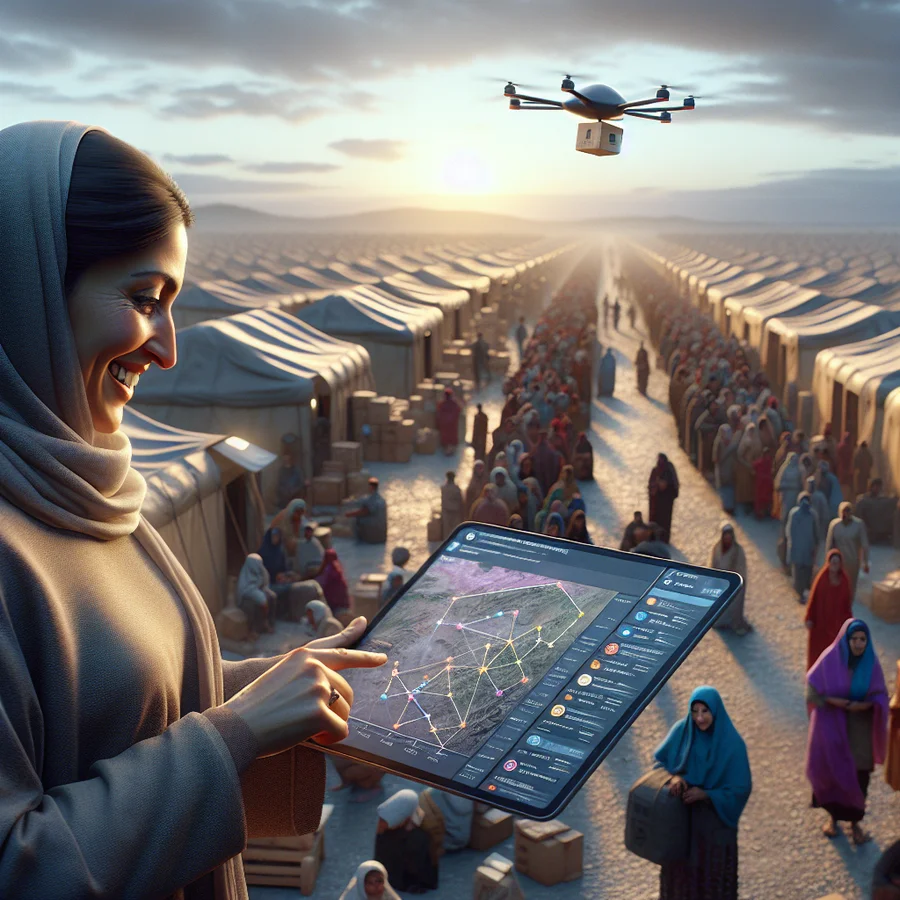AI in Humanitarian Aid: Optimizing Distribution and Enhancing Impact
Imagine a world where aid reaches those who need it most, exactly when they need it. This is the promise of AI in humanitarian aid. Artificial intelligence is rapidly changing how we respond to crises. It offers tools to predict disasters, optimize resource allocation, and improve communication. This guide explores how AI is revolutionizing humanitarian efforts, making them faster, more efficient, and more effective.
From predicting natural disasters to streamlining supply chains, AI in humanitarian aid is transforming relief efforts. It helps organizations make smarter decisions, allocate resources efficiently, and ultimately save lives. Let’s dive into the specifics of how AI is making a difference on the ground.
Understanding the Role of AI in Humanitarian Aid
Humanitarian aid faces immense challenges. These include limited resources, time constraints, and incomplete information. Traditional methods often struggle to keep up with the increasing scale and complexity of modern crises. This is where AI steps in. It offers powerful tools to enhance our ability to prepare for, respond to, and recover from disasters.
AI, or Artificial Intelligence, refers to computer systems designed to perform tasks that typically require human intelligence. These tasks include learning, problem-solving, and decision-making. In humanitarian aid, AI leverages algorithms and data analysis to improve various aspects of disaster relief and development work.
Key Applications of AI in Humanitarian Aid
AI is not just a futuristic concept; it’s a practical tool being used today. Let’s explore some specific applications where AI is making a tangible difference.
- Disaster Prediction and Early Warning Systems
- Humanitarian Mapping
- Optimizing Resource Distribution
- Healthcare Delivery
- Crisis Communication
- Humanitarian Robotics
These applications demonstrate the versatility of AI in addressing diverse challenges within the humanitarian sector. Each application enhances efficiency, accuracy, and speed in delivering aid and support to vulnerable populations.
Disaster Prediction and Early Warning Systems Using AI
Natural disasters can strike with little warning. AI can analyze vast datasets to predict these events. This includes hurricanes, floods, earthquakes, and droughts. These systems use satellite imagery, weather data, and historical records to identify patterns. Early warnings allow communities to prepare and reduce loss of life and property.
Example: Flood Prediction. AI models analyze rainfall data and river flow patterns. This helps predict flooding events days in advance. Communities can then evacuate and allocate resources effectively.
Example: Earthquake Monitoring. AI algorithms process seismic data. This helps detect precursors to earthquakes. Early response measures can then be implemented.
Humanitarian Mapping Using AI
Identifying affected areas and populations is crucial during crises. AI, combined with satellite imagery and geospatial data, creates accurate, real-time maps. This is especially vital in remote areas where traditional surveys are difficult.
Example: Damage Assessment. AI-driven image recognition analyzes satellite and drone images. This identifies damaged infrastructure, flooded areas, or destroyed buildings.
Example: Population Mapping. Tools use anonymized mobile data to estimate population density and movements. This helps in resource distribution.
Optimizing Resource Distribution with AI
Getting resources to the right place at the right time is a logistical challenge. AI analyzes supply chain data, transportation networks, and demand forecasts. This ensures that resources like food, water, medicine, and shelter materials are delivered efficiently.
Example: Route Optimization. AI algorithms find the fastest and safest routes for aid delivery. This is especially important in conflict zones or areas with damaged infrastructure.
Example: Demand Prediction. AI predicts the quantity and type of resources needed in specific locations. This prediction is based on historical data and ongoing crisis parameters.
Enhancing Healthcare Delivery with AI
AI is transforming healthcare in humanitarian contexts. It enhances disease detection, diagnosis, and treatment delivery. Key applications include:
Epidemic Prediction: AI models forecast disease outbreaks by analyzing environmental factors, mobility patterns, and historical health data. This was instrumental in tracking and managing the spread of diseases like Ebola and COVID-19.
Telemedicine and Remote Diagnostics: AI-powered diagnostic tools, such as portable devices with ML capabilities, assist healthcare workers in diagnosing diseases even in resource-scarce settings.
Drug Supply Chain Management: AI ensures the efficient distribution of medicines, minimizing wastage and addressing shortages.
Improving Crisis Communication with AI
Effective communication is essential in disaster-affected regions. It helps coordinate aid efforts and keep affected populations informed. AI-driven natural language processing (NLP) tools support:
Translation Services: AI-based translators bridge language barriers. This enables better communication between aid workers and local populations.
Social Media Monitoring: NLP tools analyze social media posts. This helps detect distress signals, misinformation, or emerging crises in real time.
The Role of Humanitarian Robotics in Aid
Robotics powered by AI is being deployed for tasks that are dangerous or inaccessible to humans. Examples include:
Search and Rescue: AI-driven drones locate survivors in collapsed buildings or flooded areas using thermal imaging and pattern recognition.
Aid Delivery: Autonomous robots and drones deliver medical supplies, food, and water to remote or conflict-ridden areas.
Ethical and Practical Challenges of AI in Humanitarian Aid
While AI offers immense potential, it also presents ethical and practical challenges. Addressing these is crucial for responsible implementation.
- Data Privacy and Security
- Algorithmic Bias
- Accessibility
- Accountability and Transparency
- Dependency on Technology
Addressing Data Privacy and Security Concerns
AI systems rely on vast amounts of data. This includes sensitive information about individuals and communities. Protecting this data from misuse is critical. Compliance with privacy regulations is essential.
Mitigating Algorithmic Bias in AI Systems
Bias in AI algorithms can lead to unequal resource distribution. It can also misidentify needs, disproportionately affecting marginalized communities. Developing diverse and unbiased datasets is essential to mitigate this risk.
Ensuring Accessibility of AI Solutions
High-tech solutions must be accessible and usable in low-resource settings. This requires designing AI tools that are robust, user-friendly, and adaptable to varying conditions.
Promoting Accountability and Transparency in AI Decision-Making
AI-driven decisions must be explainable and accountable. Humanitarian organizations must ensure that AI systems do not operate as “black boxes.” Their decision-making processes should be transparent and ethically sound.
Avoiding Over-Reliance and Dependency on AI Technology
Over-reliance on AI could lead to a lack of human oversight or critical thinking in aid operations. A balanced approach is essential. Integrate human expertise with AI capabilities.
Success Stories of AI in Humanitarian Aid
AI has already demonstrated its potential in numerous humanitarian initiatives. It has improved the efficiency, accuracy, and speed of aid delivery. Here are some success stories showcasing the transformative impact of AI.
- UN World Food Programme (WFP)
- Project Cyclone (Mozambique)
- AI in Refugee Support (UNHCR)
- Artificial Intelligence for Disaster Response (AIDR)
- Google AI for Flood Forecasting
- AI in Disease Outbreak Prediction (BlueDot and HealthMap)
- Drones Powered by AI for Search and Rescue
- Poverty Mapping by AI (World Bank and Stanford University)
- AI-Powered Chatbots for Crisis Communication
- IBM Watson’s AI for Crisis Response
- AI in Landmine Detection
- Aid Distribution with Blockchain and AI
The UN World Food Programme (WFP) and AI
The World Food Programme (WFP) uses AI to optimize food distribution during emergencies. It ensures that aid reaches those who need it most. AI systems analyze real-time data such as weather conditions, market prices, conflict zones, and population density. This provides precise recommendations on where and when to distribute food supplies.
Case Example: Rohingya Refugee Camps in Bangladesh. In the Rohingya crisis, WFP leveraged AI to ensure equitable distribution of food supplies to over a million refugees. AI-powered models helped balance supply and demand by factoring in camp population sizes, dietary needs, and accessibility issues, minimizing waste and ensuring adequate food provision.
Project Cyclone (Mozambique) and AI
In Mozambique, AI-based weather forecasting models accurately predicted Cyclone Idai’s path in 2019. By integrating meteorological data with historical cyclone patterns, AI enabled governments and humanitarian organizations to initiate timely evacuations, secure resources, and prepare medical facilities.
Impact: Thousands of lives were saved, and relief operations were better targeted. Post-disaster, AI tools were used to map the most affected areas using satellite imagery, expediting rescue operations and ensuring that relief supplies reached the hardest-hit regions.
AI in Refugee Support (UNHCR)
The United Nations High Commissioner for Refugees (UNHCR) leverages AI to improve the lives of displaced populations. By mapping refugee movements, predicting settlement trends, and analyzing needs, AI helps allocate resources more effectively.
Application Example: Syrian Refugee Crisis. AI tools were employed to analyze migration patterns of Syrian refugees fleeing conflict. Using satellite images and anonymized mobile phone data, the UNHCR predicted where new refugee camps would be required. This proactive approach reduced response times and improved living conditions for displaced families.
Artificial Intelligence for Disaster Response (AIDR)
The Artificial Intelligence for Disaster Response (AIDR) initiative, developed by the Qatar Computing Research Institute (QCRI), uses AI to analyze social media in real-time during disasters. The platform identifies tweets, posts, and messages related to distress, resource requests, or infrastructure damage, categorizing them for relief agencies.
Case Example: Nepal Earthquake (2015). During the 2015 Nepal earthquake, AIDR analyzed millions of social media posts to identify the most urgent needs. By mapping affected areas and prioritizing calls for help, AIDR provided relief organizations with actionable data, ensuring quicker and more focused interventions.
Google AI for Flood Forecasting
Google has partnered with governments and aid organizations to deploy AI-based flood forecasting systems in flood-prone regions. The system uses hydrological and meteorological data to predict riverine floods with high accuracy.
Case Example: India and Bangladesh. In 2020, Google’s AI flood forecasts helped predict floods in over 200 locations across India and Bangladesh, issuing alerts to millions of people. Families received timely notifications through smartphones, giving them critical hours to evacuate and safeguard belongings. By 2022, the program expanded to include real-time water-level tracking and increased geographic coverage.
AI in Disease Outbreak Prediction (BlueDot and HealthMap)
AI platforms like BlueDot and HealthMap monitor global health data to detect and predict disease outbreaks. These tools analyze news reports, airline ticket sales, and health records in multiple languages to identify early warning signs of epidemics.
Case Example: COVID-19 Pandemic. BlueDot was among the first systems to flag unusual cases of pneumonia in Wuhan, China, in December 2019—nine days before the World Health Organization (WHO) issued its first alert about COVID-19. This early detection allowed some countries to prepare in advance by stockpiling medical supplies and implementing travel restrictions.
Ebola Response HealthMap’s AI platform played a crucial role during the Ebola outbreak in West Africa. It monitored social media and news reports to provide a real-time understanding of the disease’s spread, enabling faster containment measures.
Drones Powered by AI for Search and Rescue
AI-powered drones have become indispensable tools in search and rescue missions. Equipped with computer vision and thermal imaging, these drones can identify survivors in disaster-hit areas more effectively than human search teams.
Case Example: Hurricane Harvey (USA). During Hurricane Harvey in 2017, drones with AI capabilities scanned flooded neighborhoods in Texas, identifying stranded individuals and mapping areas where boats or helicopters were needed. This significantly reduced the time required for rescue operations and saved hundreds of lives.
Case Example: In addition to search and rescue, AI-powered drones also assist in AI in Landmine Detection, making post-conflict areas safe again.
Poverty Mapping by AI (World Bank and Stanford University)
AI models are being used to map poverty levels in underserved regions where traditional surveys are difficult to conduct. By analyzing satellite imagery, nightlight intensity, and infrastructure patterns, AI can estimate wealth distribution and poverty levels with high accuracy.
Case Example: Sub-Saharan Africa. Stanford University researchers developed an AI system that analyzed satellite images of Sub-Saharan Africa to map poverty levels. Humanitarian organizations used these insights to prioritize aid distribution, improve education access, and address malnutrition in targeted areas.
AI-Powered Chatbots for Crisis Communication
AI chatbots have been deployed to assist individuals in disaster-affected areas, providing real-time information, emotional support, and guidance on accessing resources. These chatbots are also helpful in customer service. To know more, check out: AI Chatbots for Customer Service.
Case Example: Cyclone Amphan (India and Bangladesh). During Cyclone Amphan in 2020, humanitarian organizations launched AI chatbots on platforms like WhatsApp to communicate with affected populations. These chatbots answered questions about evacuation routes, relief centers, and medical assistance, reducing the burden on emergency hotlines.
IBM Watson’s AI for Crisis Response
IBM Watson’s AI capabilities have been harnessed to assist humanitarian efforts by analyzing unstructured data such as images, reports, and news articles. Its AI-driven insights are used to prioritize response efforts.
Case Example: Puerto Rico Hurricane Recovery. After Hurricane Maria devastated Puerto Rico in 2017, IBM Watson analyzed satellite data to assess the extent of damage to infrastructure and provided insights to aid organizations on how to allocate resources efficiently.
AI in Landmine Detection
Landmine detection is a critical aspect of post-conflict recovery. AI-powered drones and machine learning algorithms have been developed to detect landmines using hyperspectral imaging and geospatial analysis.
Case Example: Cambodia. In Cambodia, where millions of landmines remain from decades of conflict, AI-driven detection systems have located and neutralized thousands of mines, preventing injuries and deaths while making agricultural land usable again.
Aid Distribution with Blockchain and AI
Combining AI with blockchain technology, some organizations are ensuring transparency and accountability in aid distribution. AI systems analyze supply chains, while blockchain ensures every transaction is recorded and verifiable.
Case Example: Syrian Refugee Camps (World Food Programme). WFP used AI and blockchain to deliver food aid to Syrian refugees in Jordan. Refugees could purchase food using biometric data (eye scans), reducing fraud and improving accountability.
The Future of AI in Humanitarian Aid
As AI technologies continue to advance, their potential in humanitarian aid will only grow. Future developments may include:
- Advanced Predictive Models
- Personalized Aid Delivery
- Enhanced Collaboration Platforms
Advanced Predictive Models: Combining climate science, AI, and big data to predict disasters more accurately.
Personalized Aid Delivery: AI-driven systems that tailor aid packages based on the specific needs of individuals or households.
Enhanced Collaboration Platforms: AI-powered platforms that facilitate real-time collaboration between humanitarian organizations, governments, and local communities.
AI has the power to transform humanitarian aid. It can make it faster, more efficient, and more targeted. However, its implementation must be guided by ethical considerations, inclusivity, and a focus on the needs of the most vulnerable populations. By harnessing the strengths of AI while addressing its challenges, humanitarian organizations can build a more resilient and equitable system of global aid, ultimately saving lives and improving outcomes for those in crisis.
Conclusion
AI in humanitarian aid is not just a technological advancement; it’s a paradigm shift. It’s about using data and algorithms to create a more responsive, efficient, and equitable aid system. As AI evolves, its role in predicting, preparing for, and responding to crises will only increase. By embracing AI responsibly, we can build a future where aid reaches everyone in need, leaving no one behind.
FAQs about AI in Humanitarian Aid
Here are some frequently asked questions about AI in humanitarian aid:
What is AI and how is it used in humanitarian aid?
AI refers to computer systems designed to perform tasks that typically require human intelligence, such as learning, problem-solving, and decision-making. In humanitarian aid, AI is used to predict disasters, optimize resource allocation, improve communication, and enhance healthcare delivery.
What are the ethical concerns surrounding the use of AI in humanitarian aid?
Ethical concerns include data privacy and security, algorithmic bias, accessibility, accountability, and transparency. It’s crucial to protect sensitive data, mitigate bias, ensure accessibility in low-resource settings, and promote transparency in AI decision-making.
How can AI help in disaster prediction and early warning systems?
AI can analyze vast datasets, including satellite imagery, weather data, and historical records, to identify patterns and predict natural disasters such as hurricanes, floods, earthquakes, and droughts. This enables communities to prepare and reduce loss of life and property.
What role does humanitarian mapping play in AI?
AI, combined with satellite imagery and geospatial data, creates accurate, real-time maps. This helps identify affected areas and populations during crises, especially in remote areas where traditional surveys are difficult.
How does AI optimize resource distribution in humanitarian aid?
AI analyzes supply chain data, transportation networks, and demand forecasts to ensure that resources like food, water, medicine, and shelter materials are delivered to the right places at the right time.
How is AI transforming healthcare delivery in humanitarian contexts?
AI enhances disease detection, diagnosis, and treatment delivery through epidemic prediction, telemedicine, remote diagnostics, and drug supply chain management.
What is the future of AI in humanitarian aid?
Future developments may include advanced predictive models, personalized aid delivery, and enhanced collaboration platforms. AI has the power to transform humanitarian aid by making it faster, more efficient, and more targeted. Explore AI for nonprofits to see how AI can enhance their impacts.






